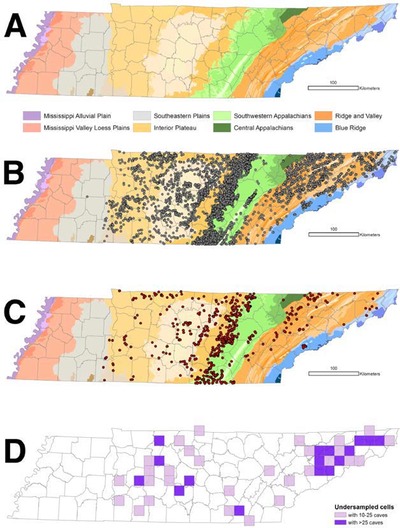

Fig. 1. Based on a study by Niemiller and Zigler (2013): (A) Ecoregions of Tennessee. (B) The gray dots indicate the distribution of 9517 georeferenced caves in Tennessee. (C) The red dots indicate the 661 caves used in the study that have at least one obligate cave species recorded in Tennessee. (D) Spatial patterns of sampling gaps in 20 x 20 km grid cells distributed across Tennessee. The most undersampled areas are darker shaded cells.
Of the >50,000 caves reported in the United States, over 1,138 cave-restricted animals have been described. These troglobionts (terrestrial obligate cave species) and stygobionts (aquatic obligate cave species) possess traits uniquely associated with life in perpetual darkness and limited food resources. One of the richest karst areas in the United States is in TAG (Tennessee, Alabama and Georgia), with Tennessee currently ranking 2nd to Texas for the most obligate subterranean species. But, recent examinations of the spatial patterns of cave biodiversity, species richness, and endemism in Tennessee identify that only 5% of Valley and Ridge caves have fauna records and several undersampled areas exist, including in northeast Tennessee extending from the more intensely inventoried southwestern Virginia karst. As such, it is possible that many TAG cave species await discovery and description. There is still much to be learned about the distribution of obligate cave fauna, their evolutionary histories, and ecosystem dynamics, which can be done from additional exploration and biological inventories, as well as from ecosystem-level investigations that include microbiology and geochemistry studies. For this project, we are addressing sampling gaps in TAG Valley and Ridge caves by (1) conducting biological inventories, to include ecological and life history information for species, and (2) documenting species occurrences that define geographic extents and examine spatial patterns of biodiversity, endemism, and sampling effort. From these data, we are (3) developing an educational outreach program that will promote awareness and conservation of subterranean fauna throughout TAG.